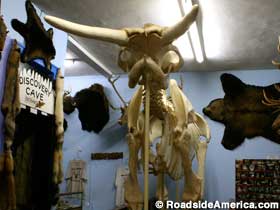
Battle Hill Museum of Natural History (Gone)
Battle Creek, Iowa
The Battle Hill Museum Of Natural History is a windowless building packed with thousands of dead animals-- more than even we had expected. It's a place where two-headed animals in jars share space with two-headed animals that are freeze-dried, and where an ox skull might fall off a wall and onto your head. It's also a vision of its creator, Dennis Laughlin -- natural history with no punches pulled, from a guy who hunts animals and hates "liberal Democrats." If an ox skull fell onto Dennis, he'd probably laugh.
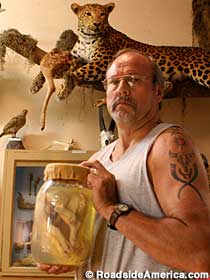
"I don't think that John Q. Public, when he gets up on Sunday morning, says to his kids, 'Let's go to a museum and learn something,'" Dennis tells us. "I think he says, "Let's go to a museum and look at all the neat junk.'" Once Dennis lures them in, there's little chance they'll leave without learning a lot -- about natural history (and freaks, okay?).
Dennis does his best to shape his Museum to his philosophy. One display, for example, is a glass-fronted box that contains what looks like a xenomorph from the Alien films. It's actually a South American Giant Anteater, with no skin. According to Dennis, it died in a zoo in the 1960s and was stuck in a freezer and forgotten until the 1990s, by which point it had become mummified. Why does Dennis display it so prominently? "Because I think it's neat," he replies. "I like it."
As for skulls, the Battle Hill Museum Of Natural History has hundreds of them, including the heads of Iowa's two famous "wandering moose" of the 1990s. "We are not supposed to have moose in Iowa," Dennis tells us. These two, he explains, wandered down from Minnesota in search of a herd or because of "a parasite in the brain." The first one, in 1989, was killed by a poacher. The second, in 1994, was hit by a truck. Both came through Battle Creek. " I guess they wanted to end up here," Dennis says. "And they did."
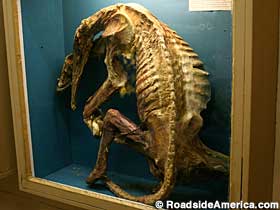
Dennis is perhaps most proud of the 12,000-pound dead elephant -- named Perkins in life -- that was dumped into his front yard. Dennis chopped it up with an ax, boiled the bones, and mounted the skeleton in his Museum. "If someone comes at you and says, 'You skin an elephant one leg at a time' -- they've never skinned an elephant," he tells us. "You do whatever's exposed, then you bring in a tractor and a loader and move it and you do something else." How did an elephant end up in his front yard? Dennis shrugs. "People come to you sometimes when they know you've got this goin' on," he says, gesturing toward a display of skins and feet. "They know the place."
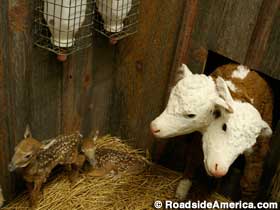
Dennis pays tribute to the geological side of natural history with "Discovery Cave," which he built in the museum basement because there are no caves in Western Iowa. At first it was a "wild cave," and Dennis gave tours by flashlight. But so many people showed up that "my voice got shot," and Dennis built the whole thing over again, this time turning it into a replica "show cave" with garishly colored lights and waterfalls. Now people can visit unescorted. The bats hanging from the ceiling are real -- and dead, of course. They came out of the attic of a nearby school.
The museum caters to school group tours and kids, as evidenced by its "Petting Zoo." In this case, it's a petting zoo where all the animals are dead, a pile of skins to fondle. The Easter Bunny is a flattened white pelt, glued on a wall next to a jackalope head.
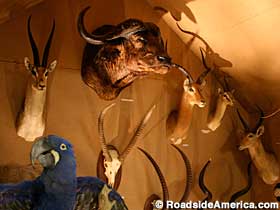
Amputated appendages, such as a tiger foot and a sea lion flipper, are clipped along the edge of displays; a teacher can pass them around to a group.
We ask Dennis about a small monster in one of the display cases. "Oh, that's a pig with two faces." he answers matter-of-factly. "They're more common than most people think."
In an adjacent room, a two-headed calf emerges from a fake barn with twin water bottles mounted next to its heads -- an example of the curator's dark sense of humor. A neighboring shelf holds a jar containing a pig with two rectums. The twinned body parts have been named in honor of Dennis and one of his friends.
The Battle Hill Museum Of Natural History is far from the politics of civilization, and exactly the way that Dennis Laughlin wants it. He built all of the exhibits, mounted all of the skeletons, wrote all of the descriptions. He follows what he calls "the chaos theory of display," which he defines as, "Put out as much junk as you can." He knows his stuff, but he doesn't take himself too seriously.
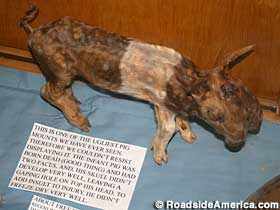
When we tell Dennis that we appreciate his efforts, he gives a self-effacing shrug. "You can't think about this stuff too much," he says. "I do my thing here. And if this place blows away or burns up, it's over. I ain't gonna redo it."



